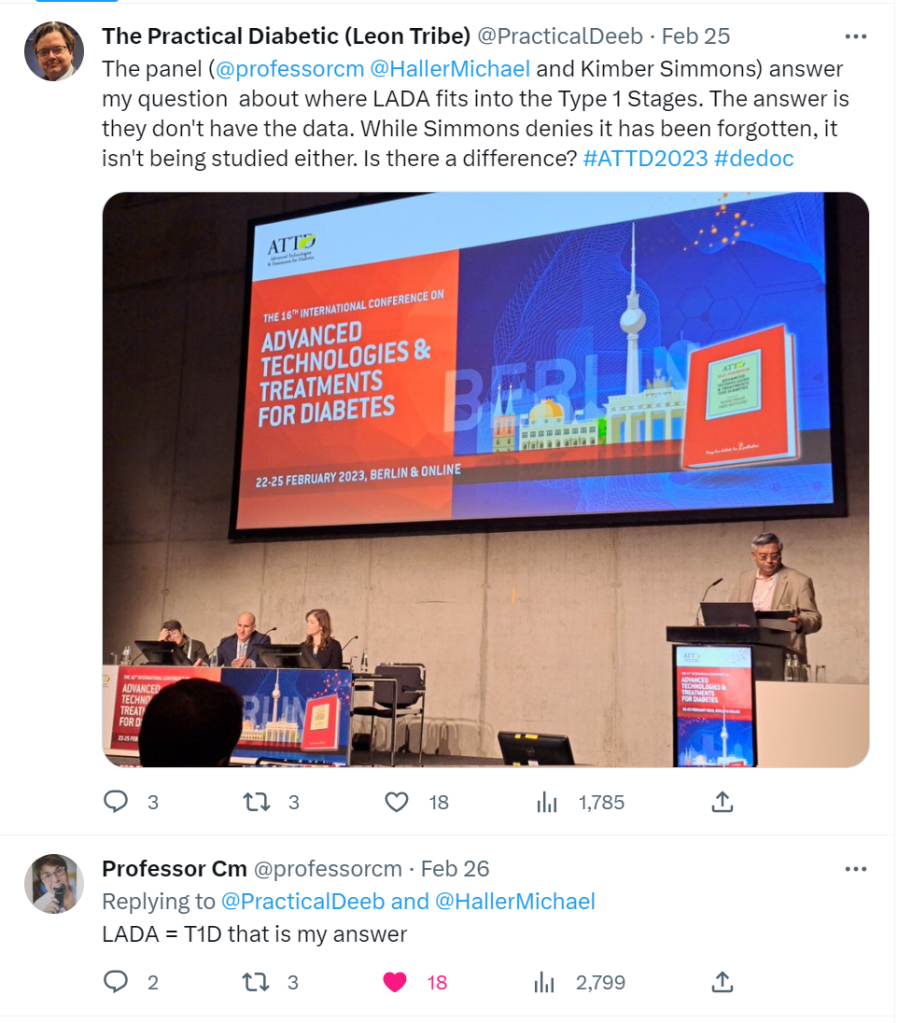This subject has been bouncing around in my head for a while and came about from an interaction with one of the giants of diabetes research: Professor Chantal Mathieu.

As a textbook LADA, I was constantly frustrated, prior to becoming insulin dependent, that I fell through the gaps on most research. Either the research wanted people recently diagnosed as type 1 or people who were insulin-dependent. Having a 5 year honeymoon insulin-independent honeymoon excluded me from both. In discussions with researchers, a practical limitation of researching LADAs is we progress so slowly meaning to bubble up statistically significant results takes timespans of years, instead of months, which is expensive from a grant perspective.
Perhaps the difficulty is our definitions. If we accept LADA is a form of stage 2 type 1 diabetes, it could be included in research studying the transition from stage 2 to stage 3 which can occupy a time period similar to the LADA honeymoon.
Type 1 Diabetes Stages
A bit of Googling brought up Milk and Honey Nutrition‘s excellent summary of the stages of type 1 diabetes.

In theory, LADA could fit into stage 1 but, usually, it is high blood sugars which leads to a diagnosis of LADA as proactive auto-antibody screening is still rare in most countries.
I fell somewhere between stages 2 and 3 at diagnosis. I tested positive for three auto-antibodies and showed symptoms typical of stage 3 but, with dietary control, I could keep reasonably normal blood sugars and a healthy HbA1c. After five years, my HbA1c began to rise and I moved to insulin before the typical symptoms of DKA showed themselves.
So Why Is LADA Distinct From Stage 2?
According to Wikipedia, LADA as a term was introduced in 1993 and a formal model of the stages came around 2015. So, there was plenty of time for LADA to establish itself as a conceptual sub-type before the stages became part of the academic diabetes zeitgeist.
There have been dissenting voices as to the need for a distinct LADA classification. This particular link makes a statistical argument, rather than one based on observational evidence and, given I tested positive for three auto-antibodies on four separate occasions and yet still had a honeymoon of years, not months, in my opinion, debunks this particular paper. I mention it simply to show there is continued debate on the subject.
Professor Mathieu’s Twitter response at the start of this article, also confirms the distinction between LADA and ‘classic’ type 1 is far from having consensus.
Where To From Here?
To settle the debate needs a few elements. The first would be a large cohort of people with stage 2 type 1 and LADA. Reviewing their characteristics and defining distinct sub-groups based on measurable parameters could tease apart the groups. As mentioned, systematic screening is still not widespread so studies of stage 2 are still relatively limited and studies of LADA are even more so. Until that changes, the distinction between LADA and stage 2 will be conjecture, more than fact.
It is accepted that type 1 is a heterogeneous disease i.e. there is no ‘true’ type 1 but, rather, many, many diseases which exhibit similar broad behaviours so LADA could well be a distinct classification. At this stage we come back to the response I got at ATTD 2023, we simply do not have the data to know and must consider it in a way which suits our purposes.
Exactly…I think before defining exactly any stages of diabetes we should treat it open minded according to individual needs. Though more research in the background would be really interesting and may someday lead to new insights.
LikeLiked by 1 person
As I’ve written in detail in my diabetes manifesto (http://typeadiabetic.com), part of the issue is bad labeling.
If we zoomed out and stopped using “Type 1” and “Type 2” and even “diabetes” we would have a much better time talking the same language and not getting caught up on technicalities that break the existing labeling system.
If, instead, we used “insulin disorder” as the base label, we could start any/all conversations with what exactly is the issue. The etymology for the word diabetes is 1000s of years old and means “pisses a lot.” So, great. A heterogeneous disease umbrella described by a single symptom.
So, let’s move forward: There can be, broadly, insulin production disorders and insulin resistance disorders. And, the best thing about this labeling approach is that they’re not mutually exclusive as it appears Type 1/ Type 2 are.
There is absolutely nothing stopping someone with an insulin production disorder also having a metabolic condition that also gives them an insulin resistance disorder.
Now, let’s talk about LADA & Type 1 in this labeling framework:
Like most physiological conditions, things occur on an continuum. There is rarely a binary activity happening in our bodies (we’re not digital). I think we can say that as the patient gets older, it generally takes more time for the immune system to dismantle the beta cells.
So, can we not simply say that insulin production disorders tend to be more rapid at youth and more gradual as the person ages? And the rate of reduced production capacity varies based on individual, and can be tested with biomarkers, but simply remains someone with an insulin production disorder.
We can certainly do “stages” of any insulin disorder if we’d like, but it would get us out of the “what exactly is Type 1 and is it inclusive of LADA or not?” debates when that debate is simply not necessary if we used more descriptive labels that lend themselves better to native comprehension.
LikeLike